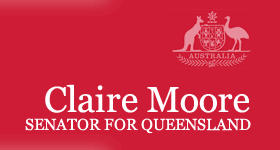Senator MOORE (Queensland) (19:42): On 9 September this year, the Speaker of the Queensland Parliament, Fiona Simpson, welcomed us to celebrate the launch of the Women's Suffrage Petition database. This is a particularly exciting and interesting historical project that has been worked on for a number of years in Queensland, and it was important that we were able to gather to talk about why it was important to see the original documents and to learn about the struggle that women had to achieve the vote and to partake in democratic processes which we value so much now. There were two key speakers on the day who talked about the issue of suffrage in Queensland: Dr Mary Crawford, who was previously the member for Forde in the House of Representatives, and Dr Deb Jordan, the senior research fellow from the National Centre for Australian Studies. They gave us the important history of these wonderful documents.
We know that in the lead-up to the centenary of women's suffrage in Queensland in 2005, which was widely celebrated across the state, there was a great search to find these wonderful documents, because we knew that they had existed. We knew that, in 1894, over 15,442 Queenslanders signed petitions that called for the right of women to vote. It is hard to read some of the script, but I am going to try to read the context of the petition into the record. It says:
That your Petitioners are of the opinion that the time has arrived when the trust of the Parliamentary Franchise can be safely and consistently extended to all white women who have been resident in the Colony for a period of six months
That your Petitioners humbly submit that as all women have to obey the Laws it is only just that they should have a voice in the selection of the Legislators who make the Laws.
That the Franchise has been granted to both White and Maori women in New Zealand and that so far as can be ascertained they have exercised their right in the true interests of Order and Good Government.
That assuming civilization is to advance its progress must be slow and long as one section of the community-a section equally as important as the other-is kept in political subjection.
Your Petitioners therefore humbly pray that your Honourable House will be pleased to take into your serious consideration the advisableness of introducing a Bill granting to White women the Franchise embodying the principles of one adult one vote and one only.
Whilst we can be disturbed by the fact that this particular process was looking exclusively at white women, we can be excited by the fact that the women and men who signed these petitions were taking a large risk; they were asking for universal suffrage at a time when the vote was still linked to land ownership in Queensland-something we are pleased to have moved on from.
Over that period there was an excitement in the community. A number of organisations were formed to look at extending the franchise. We had seen that the vote had already been achieved for women in South Australia. The Women's Equal Franchise Association, which came to spearhead the women's movement in Queensland, called for 'one person and one vote for all people in the state'. We also had the wonderful work of the Women's Christian Temperance Union, who were extraordinarily active in community politics at the time.
It is exciting that the reason we found these original petitions which are now in Parliament House was because a very good friend of mine-who I have spoken about in this place before, John McCulloch-was writing his PhD thesis on Elizabeth Brentnall, who was the wife of a legislator in Queensland and the head of the Women's Christian Temperance Union. In his research he found the original copies of the petitions. Being a true historian, he was very excited by this and could see that we needed to record it so that we could protect the originals and maintain copies so that people would be able to touch and feel and read them. Most excitingly, you can find signatories who lived in a particular area. I found the signature of someone who lived in the same street that I live in; they signed this petition in the 1890s. People can find their ancestors-their mothers, their grandmothers, the people in their families-who signed the petition.
When John found the documents-and I can almost feel that eureka moment-he and Glenda Emerson from the Queensland parliament arranged for the filming of these petitions so that they could be maintained. This was a huge exercise. The work for this was done by the Queensland Family History Society. Ms Rosemary Kopittke from the society talked about the work that was put in to ensure that we had these names protected. She said: 'We indexed 378 images covering the three petitions. In total there were 15,442 names', which exceeds the original total figure of 15,225. So even then there were some problems with numbers. She said: 'We had seven people working on various aspects of the project for over 500 hours.' She was able to show us the difficulty of reading some of the handwriting in the petitions. We had a bit of a test as to whether people could read that.
You could not help but feel inspired and excited by the project. We learned about how hard the women-and the men who supported them-worked to ensure that they got these 15,000 signatures. Remember that Queensland is a big state. We did not have emails; we did not have aeroplanes. We did not have modern technology to allow these petitions to be gathered.
We were able to find the minute book of the 12th annual convention in Bundaberg of the temperance women, where they talked about the fact that:
A petition has been drawn up for presentation to the Assembly, asking that the restrictions of sex may be withdrawn, and that women may in consequence have the rights and privileges of citizenship as we have at present the burden of being taxpayers, and responsible to the laws without the right of protecting ourselves from unjust legislation.
But they also acknowledged that there was a:
… large body of women outside the temperance cause, who are in favour of womanhood suffrage, many of whom would sign such petition if it were brought before them.
So in 1897 in Bundaberg these women arranged for copies of the petition to be sent to Thursday Island, and to the Darling Downs, Ipswich and Roma-all across the state. By gathering this work they were able to put together a petition that was put to the Queensland parliament that called for the right for women to vote.
I think we need to acknowledge the hard work of the women-and the men who supported them-to gather together this extraordinary historical document. We have now been able to protect the document, and it is now on show in Parliament House. We can celebrate their passion, their enthusiasm. But this work was done in 1894, and the women still had to wait until 1905 before they were able to get that celebration of having their first vote.
I really want to acknowledge the work of so many people who brought this project to its wonderful end. I again want to acknowledge my mate John, who is no longer with us but I know that many of us who were there on the day were thinking of him, and we knew how proud and happy he would have been.
In terms of the ongoing history, I particularly want to acknowledge the speaker, Fiona Simpson, who shares the passion for this work. On the day, she said:
… we acknowledge the strong and committed Queenslanders who initiated the women's suffrage petitions, the women who campaigned across the state from door to door to collect signatures … We also congratulate and thank all those who have contributed to creating this comprehensive database which will help us to understand more about our past and about ourselves.
I think it shows again the value of learning our history. Without this enthusiasm and hard work, these documents could have been lost to us and we would not have been able to celebrate the work or know so much about our history. This work goes on all over our country and I think we should celebrate those people who work so strenuously to ensure that our history is protected and remembered.
I have a particular interest in the whole topic of suffrage and the fact that women now have the right to vote, to argue and to be in this place. I think that is something that those people-all 15,000 and more of them-who signed those petitions could see; they perhaps saw the people who came after them having those pleasures and those responsibilities. I want to thank them. I think this is the kind of project that shows that people really do care.




